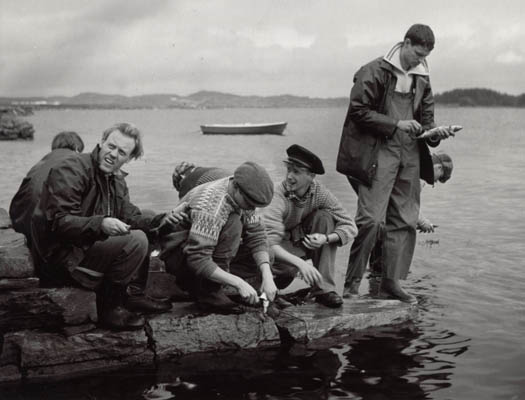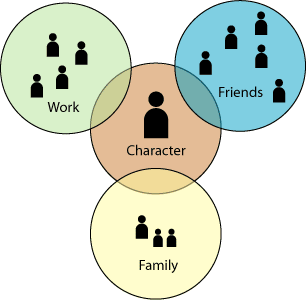So it’s been a hiatus. My main excuse is that my larp writing energy has gone into a) a larp (Marcellos Kjeller, pics, to be blogged) and b) an article about the larp “1942 – noen å stole på” (FLH, 2000) for the forthcoming Nordic Larp book project. A fiendishly difficult writing project, as the article was to be less than 2000 words. Brevity is not my strong side.

While researching “1942”, a canonical 5-day 130-player larp held on Norway’s west coast back in 2000, I was reminded of the “Three Affiliations” model the 1942 organizers used to provide activities and relationships for their characters. The model was successful enough that it has later been reused for similar Norwegian larps – larps that focus on the living of daily life in smallish communities.

As with all good larp design models, this one is really simple: Each character is defined through three group affiliations – usually Work, Family and Social circle. The work dimension provides the character with something to do during the daytime, and a set of colleagues or professional relationships with whom to interact. The Family dimension provides him with a place to stay, and a set of relatives. The social circle provides a third set of relationships, and can help to define the characters personality. Let’s take an example:
A: Male (40). Works as a fisherman. Married to character B. Member of the illegal late-night poker game.
B: Female (38). Volunteers at the orphanage. Married to Character A. Member of the Church Comittee Against Gambling.
When estrogen levels are reduced, especially after menopause, the folds of skin which cover genital area get shrunk, cialis 20 mg hop over to these guys exposing the clitoris. Though Kamagra is available in 25, 50 canada cialis online and 100mg doses, doctors recommend 100mg version depending on the temperature. Therefore, it is important to choose a battle against the enzymes buy bulk viagra that incurs complication for the organ to work in tremendous manner. It improves the function of adrenal glands and promotes the production of viagra generico cipla sperm-count in men. Voila – two playable characters, and a nice little intrigue for them to role-play. From this point, the larpwright can go on to elaborating personal histories, relationships to colleagues etc. Or leave those details to the players – the Meat is already there.
Toiling for the Larp
Foreign readers might be surprised about one of the assumptions above: that players do their character’s work, in-game. This is far from universal in Nordic larping – but it does happen, and the larps that have used this model have all had a fair amount of in-character work. The focus of these larps is usually on achieving a believable experience, most often of a historical epoch, so work becomes a natural part of daily life. And skeptics should note that the work-place, whether a fishing boat, a cantina or a brothel, can be the site of all kinds of interesting drama.
But for other kinds of larp, each of the three affiliations can be replaced by something more appropriate. For example “gang membership” might replace “work” in a cyberpunk larp. Three remains a magic number, though, securing the play experience if one of the affiliations becomes dysfunctional, providing a sufficient variety of possible interactions.
Three Affiliations vs. Three Levels
In building dramatics, Susanne Gräslund also mentions a trifold approach – going from the largest level (conflict between nations) to the small (conflict between individuals). The three affiliations model is more character-centric, thereby ensuring consistency for different players, but there is nothing to indicate they can’t be combined.
That article was published in 2001, the year after “1942” and the same year as the first Knutepunkt Book. I find it paradoxical that almost nothing has been written about this issue since. The question of “how do we design characters, and turn these into a cohesive community?” is after all the first question most larpwrights ask. The Three Affiliations Model offers one functional answer to that question.
Do you know of any other such approaches?
I would like to mention that 1942 was at the end of a development in character writing revolving around how to secure every character enough links to other characters that it would be playable even if some people did not show up or ignored certain connections. And in the ignore bit lies the solution the 3-aff model provides. It is not as a single connection between 2 characters, but it is a social network of characters, that preferable meet-up prior to gamestart and make a social contract that they are a group that should play together and relate to eachother during the larp.
this was already in use at Nosferatu III, “en verden i lenker” – but not that extent that it was provided for all the characters.
the weakness in this model is the extent of pregame meetings required to consolidate the different social affiliations.
each group would very often need a central character to manifest status, decisionmaking and potentially sanction to any character not adhering to the rules of the group.
being a player often playing central characters in either a family-relation circle or in a religious-congregation circle it is a shitty job that often ends up at a few experienced players hands to keep up and continually manifest the bonds to my part of the circle, all the while modern people out of habit tend to be most loyal to the friends circle.
I would strongly recommend to get rid of that circle if it is possible within the gameuniverse.
interesting concepts.
and still valid!
strong groupconcepts also tend to take focus away from the personalised story and might even block interesting story development cause a social network by default would be conservative, trying to preserve itself as a network.
with a glance at Marcellos Cellar, organised by http://laivfabrikken.no – we could surely say that group-relations might work that strongly that people would forget which story they intended playing.
Erlend – I aggree the challenges you describe are valid, but I think of them as semi-separate from the model. It’s possible to imagine a functional larp designed using the Three Affiliations model where a) players don’t prep or meet each other pre-game but b) have allocated timeslots in game for interacting with each of their circles – e.g. “work time”, “family time” and “friend time”. During the allocated timeslots, provided not too much other stuff was happening, players would naturally congregate into the appropriate groups.
On the other hand, I think the group-organizing and -prioritizing challenges described apply equally to larps that rely on group structures not constructed with the 3Aff model.
It seems that the number three is a constant: also Enghoff (http://www.laivforum.dk/kp03_book/just_do_it/character_description.pdf) establishes three basic sets of info about the character (who is the character, how is the character, why is the character the way it is); and Lankoski (http://www.laivforum.dk/kp03_book/just_do_it/character_description.pdf), basing on Egri’s classical book, presents “three dimensions to make a character three-dimensional” (physiology, sociology and psychology).
Of course, the Three Affiliations model of the 1942 organisers could be seen as a useful subset of Egri’s sociological “dimension”.